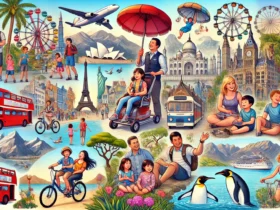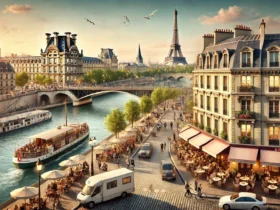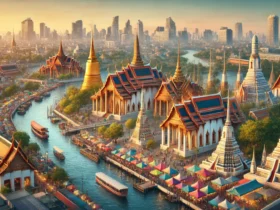Washington, D.C., the capital of the United States, is a city rich in history, culture, and diversity. Whether you’re a first-time visitor or a local exploring new sights, D.C. offers a range of attractions that cater to all interests. From iconic monuments and museums to lively neighborhoods and beautiful parks, here are the best places to visit in Washington, D.C.
1. The National Mall: America’s Front Yard
The National Mall is often considered the heart of Washington, D.C., and it’s a must-visit for anyone exploring the city. Stretching from the U.S. Capitol to the Lincoln Memorial, this vast, tree-lined expanse is home to some of the nation’s most famous monuments and memorials.
Highlights of the National Mall:
- Lincoln Memorial: A tribute to President Abraham Lincoln, featuring a massive seated sculpture and inscriptions of his most famous speeches.
- Washington Monument: The world’s tallest stone structure and obelisk, offering panoramic views of the city from its observation deck.
- World War II Memorial: Honors the 16 million people who served in the U.S. armed forces during World War II.
- Reflecting Pool: A serene body of water between the Lincoln Memorial and the Washington Monument, perfect for photos and peaceful walks.
- Martin Luther King Jr. Memorial: Commemorates the civil rights leader’s legacy, with a towering stone statue and inspirational quotes.
Tips for Visiting the National Mall:
- Wear comfortable shoes; the Mall covers a large area, and you’ll be walking a lot.
- Visit early in the morning or late in the afternoon to avoid crowds and enjoy cooler temperatures.
- Check the National Park Service website for any special events or tours that may be happening during your visit.
2. Smithsonian Museums: A Treasure Trove of Knowledge
Washington, D.C. is home to the Smithsonian Institution, the world’s largest museum, education, and research complex. Many of the Smithsonian museums are located on or near the National Mall, and best of all, admission is free.
Must-Visit Smithsonian Museums:
- National Museum of American History: Explore exhibits ranging from the original Star-Spangled Banner to the First Ladies’ Inaugural Gowns.
- National Air and Space Museum: Home to the largest collection of historic aircraft and spacecraft in the world, including the Wright Brothers’ plane and the Apollo 11 Command Module.
- National Museum of Natural History: Features the famous Hope Diamond, a massive collection of fossils, and interactive exhibits about Earth’s history.
- National Museum of African American History and Culture: A powerful journey through the history, culture, and contributions of African Americans.
- Hirshhorn Museum and Sculpture Garden: A modern art museum with a vast collection of contemporary works and an outdoor sculpture garden.
Tips for Visiting the Smithsonian Museums:
- Plan your visit ahead of time and prioritize the museums that interest you the most; there’s a lot to see!
- Consider visiting on weekdays and during off-peak hours to avoid crowds.
- Check museum websites for any special exhibits, events, or temporary closures.
3. The U.S. Capitol and Capitol Hill: Political Powerhouse
The U.S. Capitol is one of the most recognizable symbols of American democracy. Located on Capitol Hill, the Capitol is the home of the United States Congress and a site of immense historical significance.
Highlights on Capitol Hill:
- U.S. Capitol Building: Take a guided tour to explore the Rotunda, Statuary Hall, and learn about the legislative process.
- Library of Congress: The largest library in the world, with stunning architecture and a vast collection of books, manuscripts, and historical artifacts.
- Supreme Court of the United States: Visit the highest court in the nation and learn about its role in American law.
- United States Botanic Garden: A beautiful oasis featuring a variety of plants, including rare and endangered species.
Tips for Visiting Capitol Hill:
- Book tours of the U.S. Capitol and Library of Congress in advance, as they can fill up quickly.
- Check the schedules for congressional sessions or hearings if you’re interested in witnessing government in action.
- Explore the neighborhood for charming cafes, shops, and historic homes.
4. Georgetown: Historic Charm and Waterfront Views
Georgetown is one of D.C.’s oldest and most picturesque neighborhoods, known for its cobblestone streets, historic row houses, and waterfront views. It’s a great place to stroll, shop, dine, and enjoy the city’s vibrant atmosphere.
Highlights in Georgetown:
- Georgetown Waterfront Park: Offers scenic views of the Potomac River, with walking and biking paths, picnic spots, and kayaking opportunities.
- Georgetown University: The oldest Catholic and Jesuit university in the U.S., with a beautiful campus worth exploring.
- M Street and Wisconsin Avenue: Lined with boutiques, antique shops, and eateries, these streets are perfect for shopping and people-watching.
- Dumbarton Oaks: A historic estate with stunning gardens and a museum showcasing Byzantine and Pre-Columbian art.
Tips for Visiting Georgetown:
- Wear comfortable shoes; Georgetown’s cobblestone streets can be uneven.
- Consider taking a boat tour or renting a kayak to explore the Potomac River.
- Visit the area in the evening to enjoy waterfront dining and vibrant nightlife.
5. The Tidal Basin and Cherry Blossoms: A Seasonal Spectacle
The Tidal Basin is a man-made reservoir adjacent to the National Mall, famous for its stunning cherry blossom trees that bloom each spring. This area is also home to several important monuments and memorials.
Highlights Around the Tidal Basin:
- Jefferson Memorial: Dedicated to Thomas Jefferson, the third U.S. President, with a neoclassical design inspired by the Roman Pantheon.
- FDR Memorial: A tribute to President Franklin D. Roosevelt, featuring waterfalls, sculptures, and quotes from his presidency.
- Martin Luther King Jr. Memorial: Honors the civil rights leader with a massive stone sculpture and peaceful surroundings.
- Cherry Blossom Festival: Held each spring, celebrating the blooming of thousands of cherry trees gifted by Japan in 1912.
Tips for Visiting the Tidal Basin:
- Visit during the Cherry Blossom Festival (late March to early April) for a unique experience, but be prepared for crowds.
- Rent a paddleboat for a fun way to explore the Tidal Basin.
- Bring a picnic and enjoy the scenic views of the monuments and water.
6. The National Zoo: A Family Favorite
The Smithsonian’s National Zoo is a beloved destination for families and animal lovers. Located in Rock Creek Park, this free zoo is home to over 2,000 animals, including giant pandas, lions, elephants, and more.
Highlights of the National Zoo:
- Giant Panda Habitat: Home to the zoo’s famous giant pandas, one of the main attractions.
- Asia Trail: Features Asian species such as red pandas, clouded leopards, and sloth bears.
- Amazonia Exhibit: A simulated rainforest environment with exotic birds, fish, and other wildlife.
- Kids’ Farm: An interactive area where kids can meet and learn about farm animals.
Tips for Visiting the National Zoo:
- Arrive early to avoid crowds and see the animals when they are most active.
- Wear comfortable walking shoes; the zoo is spread out over a large area with hilly terrain.
- Bring water and snacks, although there are several cafes and food vendors on-site.
7. Dupont Circle: Arts, Culture, and Nightlife
Dupont Circle is one of D.C.’s trendiest neighborhoods, known for its lively atmosphere, diverse dining options, and cultural attractions. It’s a great place to explore local art, enjoy a good meal, or simply people-watch.
Highlights in Dupont Circle:
- The Phillips Collection: America’s first museum of modern art, featuring works by Renoir, Rothko, and van Gogh.
- Embassy Row: A stretch of Massachusetts Avenue lined with international embassies, each with its unique architecture.
- Dupont Circle Fountain: A central gathering spot surrounded by cafes, shops, and historic homes.
- Kramerbooks & Afterwords Cafe: A local institution, combining a bookstore with a cozy cafe.
Tips for Visiting Dupont Circle:
- Explore the area on foot or by bike to fully appreciate its charm.
- Check out the Farmers Market held every Sunday morning for local produce and crafts.
- Enjoy the vibrant nightlife with numerous bars, restaurants, and music venues.
8. The White House: A Symbol of American Leadership
The White House, the official residence and workplace of the President of the United States, is a must-see for any visitor to Washington, D.C. While public tours are limited, there are several ways to experience this iconic building.
Tips for Visiting the White House:
- Request a tour through your member of Congress months in advance, as spots are limited and fill up quickly.
- Visit the White House Visitor Center for exhibits and artifacts related to the history of the building and its residents.
- Walk around Lafayette Square for excellent views and photo opportunities of the White House.
Frequently Asked Questions (FAQs)
1. What is the best time to visit Washington, D.C.?
The best time to visit Washington, D.C., is during the spring (March to May) or fall (September to November) when the weather is mild, and the city’s famous cherry blossoms or fall foliage are at their peak.
2. Are the Smithsonian museums free?
Yes, all Smithsonian museums in Washington, D.C., offer free admission, though some special exhibitions or events may require tickets.
3. How can I get around Washington, D.C.?
Washington, D.C. has an extensive public transportation system, including the Metro, buses, and bike-sharing services. Walking is also a great way to explore many of the city’s main attractions.
4. What are the must-see monuments on the National Mall?
Must-see monuments on the National Mall include the Lincoln Memorial, Washington Monument, Martin Luther King Jr. Memorial, and the World War II Memorial.
5. Is it safe to visit Washington, D.C. at night?
Most tourist areas in Washington, D.C., are safe to visit at night, but it’s always wise to stay in well-lit, populated areas and be aware of your surroundings.
6. Where can I find good food in D.C.?
D.C. offers a diverse culinary scene, from fine dining to food trucks. Popular areas for food include Georgetown, Dupont Circle, and the U Street Corridor.
Washington, D.C. is a city that offers something for everyone, from history buffs and art lovers to families and food enthusiasts. Whether you’re visiting for a weekend or an extended stay, these attractions will provide a memorable experience in the nation’s capital.






Leave a Reply